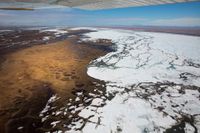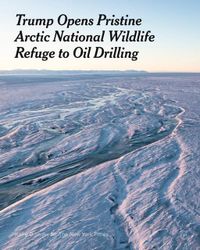On October 24, 2025, the Trump administration reignited one of America’s most fiercely debated land use battles, finalizing plans to open the entirety of Alaska’s Arctic National Wildlife Refuge (ANWR) coastal plain to oil and gas drilling. The announcement, made by the Department of the Interior (DOI), marks a pivotal moment in a decades-long struggle over whether to develop or protect one of the nation’s last great wildernesses—a place revered by Indigenous communities, coveted by energy developers, and watched closely by environmentalists worldwide.
Interior Secretary Doug Burgum stood in Washington, D.C., alongside Alaska’s Republican Governor Mike Dunleavy and the state’s congressional delegation to unveil what he called a “sweeping package of actions to boost energy development, modernize land and resource management across Alaska.” According to NPR, the plan not only paves the way for the first of at least four lease sales over a ten-year period—mandated by a Republican bill packed with tax breaks and spending cuts passed earlier in the summer—but also reinstates seven oil leases in the refuge previously canceled by the Biden administration in 2023. A federal judge had ruled in March that the Biden administration lacked authority to void these leases, which had been acquired by a state corporation in the waning days of Trump’s first term.
“From day one, President Trump directed us to unlock Alaska’s energy and resource potential while honoring commitments to the state and local communities,” Burgum declared, as reported by The Associated Press. “By reopening the Coastal Plain and advancing key infrastructure, we are strengthening energy independence, creating jobs and supporting Alaska’s communities while driving economic growth across the state.”
The scale of what’s at stake is enormous. The 1.56 million-acre coastal plain—stretching across the northernmost reaches of Alaska—could hold as much as 11.8 billion barrels of recoverable oil beneath its tundra, according to Outdoor Life. The Bureau of Land Management is already soliciting nominations for which tracts should be included in the upcoming lease sales, expected to begin as soon as this winter. The DOI’s new Record of Decision replaces an earlier plan, signaling a full-throttle push to realize President Trump’s executive order from January, which positioned ANWR at the heart of his strategy to unleash Alaska’s “extraordinary resource potential.”
But for all the political momentum, the move has exposed deep and enduring rifts—especially among Alaska’s Indigenous peoples. The Gwich’in, whose villages lie near the refuge, have long considered the coastal plain sacred, calling it “the place where life begins” for the Porcupine Caribou Herd, a vital resource for their culture and subsistence. “This decision directly contradicts years of Gwich’in engagement and advocacy that makes clear any drilling on this land would cause irrevocable harm to the Gwich’in and our way of life,” said Galen Gilbert, First Chief of Arctic Village Council, in a statement released by the Gwich’in Steering Committee. The group’s executive director added that the administration’s efforts “exploit the calving grounds of the Porcupine Caribou herd for short-term gain.”
Environmental organizations have echoed these concerns. Meda DeWitt, Alaska senior manager with The Wilderness Society, stated, “the administration is placing corporate interests above the lives, cultures and spiritual responsibilities of the people whose survival depends on the Porcupine caribou herd, the freedom to live from this land and the health of the Arctic Refuge.” The refuge, as NPR notes, is also internationally recognized for its vital habitat supporting migrating waterfowl.
Yet, the picture is far from one-sided. The Iñupiaq community of Kaktovik, which sits within the refuge, has thrown its weight behind responsible oil development, seeing it as essential for economic well-being and local services. “It is encouraging to see decision makers in Washington advancing policies that respect our voice and support Kaktovik’s long term success,” said Charles “CC” Lampe, president of the Kaktovik Iñupiat Corp, in a statement cited by both AP and NPR. The Voice of the Arctic Iñupiat, a coalition supporting drilling, underscored that “over 95 percent of the North Slope’s tax revenue is derived from taxation of resource development infrastructure, not output,” funding everything from community infrastructure to wildlife management and Indigenous traditions.
The debate over drilling is only one front in a broader transformation of Alaska’s public lands. Thursday’s announcement also included completion of a land exchange deal to build an 11-mile, one-lane, gravel, noncommercial-use road connecting King Cove and Cold Bay through the Izembek National Wildlife Refuge. The road, long sought by King Cove residents to access emergency medical care at Cold Bay’s all-weather airport, has been championed by Alaska’s congressional delegation as a “life and safety issue.” Senator Lisa Murkowski, a Republican, emphasized, “I think it’s important to remember that nobody’s talking about a multi-lane paved road moving lots of big trucks back and forth. It is still an 11-mile, one-lane, gravel, noncommercial-use road.”
But conservationists and some tribal leaders are preparing to fight the road in court, warning it could devastate critical habitat for migratory birds and other wildlife. The Center for Biological Diversity described the land swap as trading about 500 acres of “ecologically irreplaceable wilderness lands” for up to 1,739 acres of King Cove Corporation lands outside the refuge. “I worry every day about what’s going to happen to the brant and emperor geese if there’s a road in Izembek,” said Edgar Tall Sr., chief of the Native Village of Hooper Bay, in a statement to the Center for Biological Diversity. “Our people hunt these birds together so we can learn from each other and teach our children how to hunt and take care of the land.”
The administration’s “sweeping package” also advanced the controversial Ambler Road project—a 211-mile private industrial corridor that would open access to mining deposits south of the Brooks Range. Right-of-way permits for Ambler have been granted, and nearly 23,600 acres near Ambler have been conveyed to the state, “completing the state’s selections in the area and advancing local control over land use and resource development,” the DOI said. Still, the Ambler Road faces lawsuits and fierce opposition from environmentalists and some local communities, who warn it would cut through the winter range of the Western Arctic Caribou Herd and defy decades of public input.
As the administration moves to “reduce regulatory barriers, support local communities, and strengthen Alaska’s role in national energy security and economic growth,” the battle lines are drawn. For some, these actions represent long-overdue recognition of Alaska’s resource potential and the economic aspirations of its residents. For others, they threaten irreplaceable landscapes, vital wildlife, and the cultural heritage of Indigenous peoples. The coming months—marked by lease sales, legal challenges, and continued public outcry—promise to shape the fate of Alaska’s wild north for generations.


